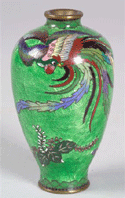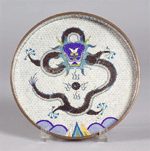|
Cloisonné Prices
Depend On Age and Design
By Anne Gilbert
As the April 14 Skinner Asian auction proved, big prices can come in small
pieces. Just four inches high, a Ming period (1368-1644) Chinese vase zoomed
past the estimated $500/$700 to sell for $4,700. At the bottom end was a
beautiful, late 19th century Japanese cloisonné vase that fetched $206. The vase
had an estimate of $200/$400. Popular with American collectors from the late
19th to the early 20th century, until recently it was out-of-fashion.
|

|
Japanese cloisonné vase, late 19th century. |
The
many inexpensive contemporary pieces now being imported from China are finding a
new generation of collectors. Unfortunately many are sold to buyers as
old.
Historically, it was during the Ming Dynasty (1368-1643) that Chinese
artisans began adapting the techniques used in the Middle Eastern nations for
making cloisonné. The Chinese used cast bronze forms, ribbons and wires. By the
15th century, copper replaced bronze since it was easier to work with. Though
the early colors were limited, the turquoise that came to be known as "Ming
Blue" was used from then through the 18th century. Among the designs were
five-clawed dragons, ho-ho birds, animals, human figures, landscapes and water
fowl. By the 17th century, designs became more formal, and scrolling was
used.
By the mid-19th century, cloisonné became a popular American import. As
a result of nearly mass production, the quality was poor.
Some of the finest
cloisonné was made in Japan around 1830. The earliest used Chinese motifs, often
with a reddish brown sprinkled with gold backgrounds. By the late 19th century,
they had refined the use of transparent enamels over silver or aluminum foil
with backgrounds of pressed designs. By using fine wires, the effect was of an
unbroken painting.
Chinese cloisonné tray, early 20th century. (Photos, courtesy Skinner
Auctions, Boston, MA.) |

|
Similar in appearance is champlevé. It creates the
patterns by casting or chiseling, then filling them in with enamels. In yet
another technique, plique-a-jour transparent enamels are poured into honeycomb
pattern wires. The effect is similar to stained glass.
CLUES: Among the new
fake cloisonné are mass-produced plastic products. They are made out of a proxy
resin instead of glass, and the bases are metal instead of copper. They are
lighter in weight and scratch easily.
Other earlier fakes abound, dating to
the 19th century. Most typical are shallow trays and plates with bird designs.
Faked incised marks that aren't enameled could have been added at any time.
Japanese cloisonné is often signed by the artist or has maker's marks.
Considered one of the known masters of Japanese cloisonné is Nami-kawa Sosuke
(1868-1912). Examples of his work can sell for thousands of dollars.
Best
advice: see authenticated examples before plunging into collecting.
|